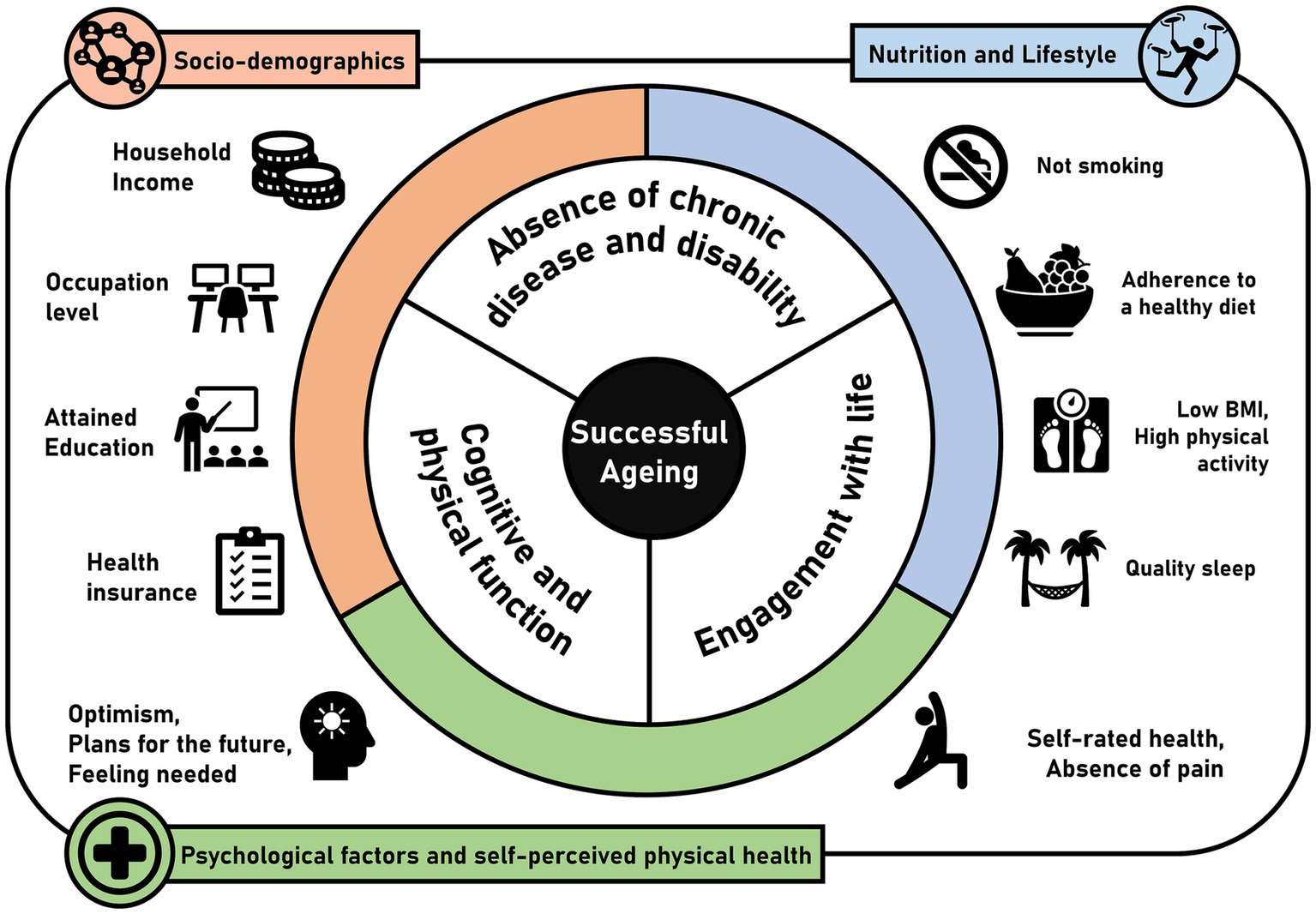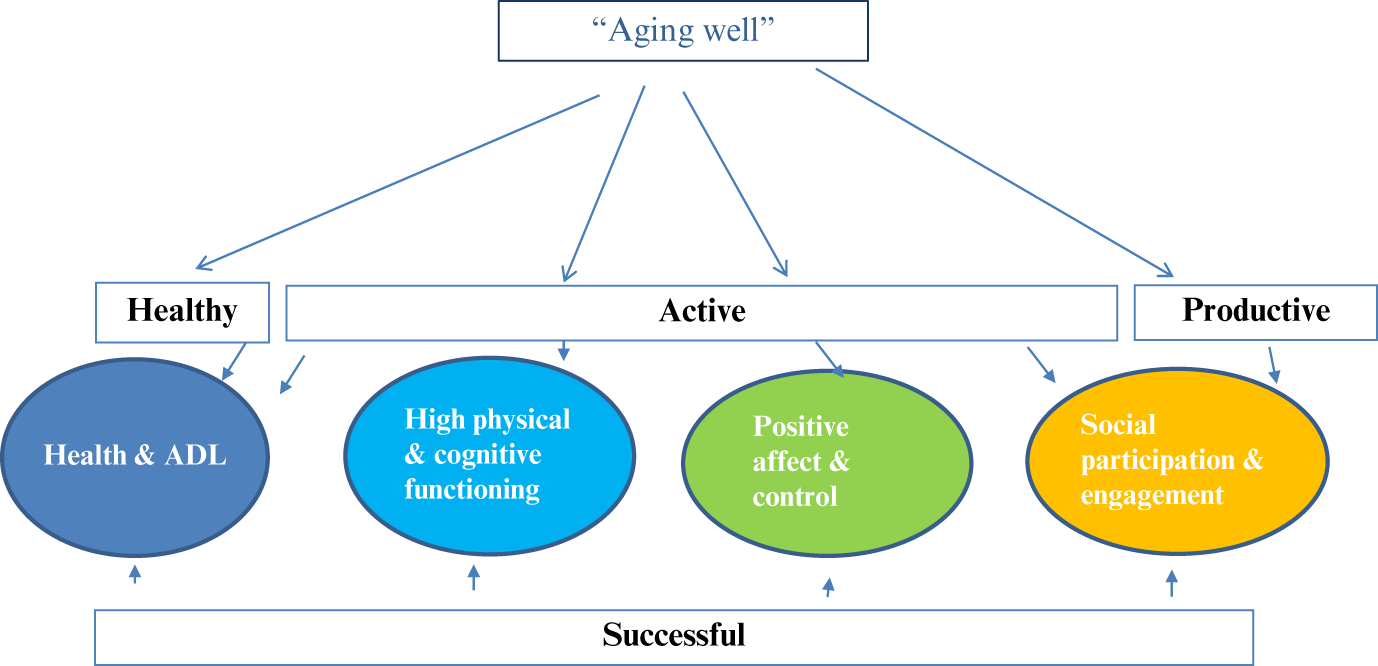Introduction
Successful aging has become one of the most widely discussed topics in developmental psychology, gerontology, and health sciences. The concept represents not only longevity but also maintaining physical health, cognitive competence, emotional well-being, and meaningful social engagement in later life (Schulz, 2006). Within this framework, personality is regarded as a fundamental determinant of how individuals adapt to the aging process. Personality influences coping styles, interpersonal relationships, health behaviors, and perceptions of life satisfaction, thereby serving as a predictor of successful aging across diverse cultural and social contexts (Feldman & Babu, 2011).

Successful Aging
Read More: Geropsychology
Theoretical Foundations
Some of the most important theoretical perspectives include:
1. Lifespan Developmental Theory
Lifespan psychology, championed by scholars like Baltes, Birren, and Schaie, provides a critical backdrop for understanding personality and aging. According to Hurlock (1981), personality is not static but undergoes qualitative and quantitative shifts across developmental stages. Aging must be viewed as a process of adaptation and change that continues into late life, shaped by both gains and losses.
Baltes’ lifespan developmental principles highlight:
- Multidirectionality – personality traits may increase (e.g., emotional regulation) while others decline (e.g., sensation-seeking).
- Plasticity – even in late adulthood, individuals can develop resilience, adopt new coping strategies, or cultivate spiritual maturity.
- Contextualism – aging outcomes depend on interactions between individual traits and environmental settings.
- Historical embeddedness – personality and aging are influenced by historical and cultural contexts, such as changing roles for older adults in modern society.
This lens positions personality as a dynamic resource, not merely a fixed predictor.
2. Erikson’s Psychosocial Theory
Erikson’s model (though not directly in the provided references, it aligns with Hurlock, 1981, and Birren & Schaie, 2001) is crucial to personality and aging. The eighth psychosocial stage—Integrity vs. Despair— highlights how personality traits like openness, resilience, and conscientiousness help older adults integrate life experiences into a coherent sense of meaning.
- Individuals high in traits like optimism and agreeableness are more likely to achieve integrity by accepting their lives with satisfaction.
- Those high in neuroticism may struggle with despair, regret, or existential anxiety.
Thus, Erikson’s stage theory directly links personality development with successful or unsuccessful aging.
3. Trait Theory and the Big Five
The trait perspective, discussed in Birren & Schaie (2001), emphasizes relative stability in personality across adulthood. Longitudinal studies suggest that while personality remains fairly stable, late life is marked by subtle trends—such as decreased neuroticism and increased agreeableness—that promote adaptation.
- Conscientiousness is linked with healthier aging behaviors, longer life expectancy.
- Extraversion is associated with better social networks and life satisfaction.
- Openness is supports cognitive flexibility and lifelong learning.
This theory situates personality traits as predictors of aging outcomes.
4. Socioemotional Selectivity Theory (SST)
Although more prominent in health psychology, Carstensen’s socioemotional selectivity theory (echoed in Taylor, 1999, and Schulz, 2006) adds nuance. It suggests that as people age and perceive time as limited, they prioritize emotionally meaningful goals and relationships.
Personality plays into this by:
- Extraverts naturally seeking emotionally rewarding interactions.
- Agreeable individuals sustaining supportive relationships.
- Optimists maintaining a positive focus on present emotional well-being.
This aligns with successful aging because it emphasizes adaptive re-prioritization of social and emotional goals.
5. Health Psychology Framework
Taylor (1999) situates personality in the context of health behaviors and stress management. According to this view:
- Traits like optimism and hardiness foster proactive coping, reduced stress reactivity, and better physical health.
- High neuroticism amplifies stress responses, leading to poorer health outcomes such as cardiovascular disease.
- Perceived control—closely linked to conscientiousness—protects against learned helplessness in old age.
Thus, health psychology highlights how personality moderates the mind-body connection in aging.
6. Gerontological Models of Successful Aging
Gerontological theories, such as Rowe and Kahn’s model (cited by Schulz, 2006), identify three dimensions of successful aging:
- Avoidance of disease and disability
- Maintenance of physical and cognitive function
- Active engagement with life
Personality intersects with each of these:
- Conscientiousness aids in disease avoidance via health-promoting behaviors.
- Openness and optimism foster cognitive engagement and learning.
- Extraversion and agreeableness sustain active social participation.
Thus, gerontology recognizes personality as a core factor influencing whether individuals meet the criteria of successful aging.
7. Spiritual and Existential Theories
Johnson & Walker (2016) emphasize the spiritual dimensions of aging, which tie personality to meaning-making, transcendence, and acceptance of mortality. Traits like humility, compassion, and spiritual openness enrich older adults’ psychological well-being and resilience in facing end-of-life issues.
This perspective is particularly relevant in cultures where religion and spirituality shape the definition of successful aging, complementing Western psychological frameworks.

Successful Aging
Personality Traits and Their Role in Successful Aging
One of the most commonly used frameworks for studying personality is the Big Five model, which includes openness, conscientiousness, extraversion, agreeableness, and neuroticism. Each of these traits has been associated with different aspects of successful aging:
- Openness fosters curiosity and adaptability, helping older adults embrace new experiences and cope with change.
- Conscientiousness is strongly linked to health-promoting behaviors, longevity, and reduced risk of cognitive decline.
- Extraversion supports social participation and positive affect, which are essential for maintaining life satisfaction.
- Agreeableness facilitates harmonious relationships and social support networks, crucial for emotional well-being.
- Low Neuroticism correlates with reduced risk of depression, anxiety, and stress-related health problems.
Optimism and Resilience
Beyond the Big Five, traits such as optimism and resilience play a pivotal role. Optimistic individuals are more likely to engage in proactive coping and perceive challenges as manageable (Taylor, 1999). Resilience, meanwhile, reflects the capacity to bounce back from adversity and maintain psychological stability despite losses commonly experienced in later life (Johnson & Walker, 2016).
Spirituality and Personality
Personality is also shaped by spiritual and existential dimensions. Johnson and Walker (2016) argue that traits such as humility, transcendence, and compassion contribute to a deeper sense of purpose in aging, buffering against existential anxiety. These qualities align with broader cultural and religious frameworks of successful aging.

Successful Aging
Cultural and Contextual Influences
Personality and aging cannot be fully understood without acknowledging cultural contexts. Eyetsemitan and Gire (2003) emphasize that most theories of aging originate from Western perspectives, which may not fully apply to the developing world. In collectivist cultures, traits like agreeableness and conformity may carry more weight in determining successful aging, as they align with social harmony and interdependence.
For example, in many non-Western societies, family support plays a central role in older adults’ well-being. Here, personality traits that foster cooperation, respect, and familial commitment may be more strongly associated with successful aging than independence or individual achievement (Hurlock, 1981).
Moreover, socio-economic conditions shape the expression of personality traits. In resource-limited environments, resilience and adaptability may be particularly important for maintaining well-being in old age.
Personality, Health, and Coping
Personality traits have significant implications for physical health. Conscientious individuals are more likely to maintain healthy lifestyles, avoid risky behaviors, and adhere to medical advice (Birren & Schaie, 2001). In contrast, high levels of neuroticism are associated with hypertension, cardiovascular risk, and poorer recovery from illness (Taylor, 1999).
Mental Health and Coping Strategies
Personality also shapes coping strategies in response to stress. Positive traits such as extraversion and openness encourage problem-focused coping, while high neuroticism predisposes individuals to avoidance or emotion-focused coping (Comer, 2007). Effective coping mechanisms are crucial for maintaining psychological well-being in the face of age-related losses, including bereavement, declining physical function, and reduced social roles.
Social Relationships
Extraversion and agreeableness enhance social connectivity, which has been shown to protect against depression, cognitive decline, and mortality (Schulz, 2006). Conversely, individuals with high neuroticism may experience strained relationships, leading to social isolation and reduced life satisfaction.
Critiques and Limitations
While personality is undeniably linked to successful aging, there are limitations to this perspective. First, personality is not the sole determinant of aging outcomes; biological, environmental, and socio-economic factors also play critical roles (Feldman & Babu, 2011). Second, the emphasis on stable personality traits may overlook the capacity for change and growth in late life. Older adults can cultivate resilience, optimism, and emotional regulation through interventions and supportive environments (Birren & Schaie, 2001).
Furthermore, applying Western-based personality models universally may ignore cultural variations in values and definitions of successful aging (Eyetsemitan & Gire, 2003). For instance, independence may be a marker of successful aging in Western contexts but less relevant in collectivist societies where interdependence is valued.
Conclusion
Personality plays a critical role in shaping the pathways to successful aging by influencing health behaviors, coping strategies, social engagement, and overall well-being. Traits such as conscientiousness, extraversion, agreeableness, and low neuroticism are consistently associated with positive aging outcomes, while optimism, resilience, and spirituality add depth to our understanding of adaptive functioning in later life.
However, personality must be understood within broader cultural and socio-economic contexts, as well as in interaction with health, environment, and social structures. Successful aging is best conceptualized as a dynamic interplay between personality, life circumstances, and individual adaptation.
By integrating psychological, cultural, and health-related perspectives, scholars and practitioners can foster interventions that enhance personality-related strengths, promote resilience, and support meaningful engagement throughout the lifespan.
References
Birren, J. E., & Schaie, K. W. (2001). Handbook of the Psychology of Aging (5th ed.). Academic Press: London.
Comer, R. J. (2007). Abnormal Psychology (6th ed.). Worth Publishers.
Elizabeth, B. Hurlock (1981). Developmental Psychology: A Life-Span Approach (5th ed.). Tata McGraw-Hill: Delhi.
Eyetsemitan, F. E., & Gire, J. T. (2003). Aging and Adult Development in the Developing World: Applying Western Theories and Concepts. Library of Congress.
Feldman, R. S., & Babu, N. (2011). Discovering the Life Span. Pearson.
Johnson, M., & Walker, J. (2016). Spiritual Dimensions of Aging. Cambridge University Press: UK.
Schulz, R. (2006). The Encyclopaedia of Aging: A Comprehensive Resource in Gerontology and Geriatrics (4th ed.). Springer Publishing Company, Inc.
Taylor, S. E. (1999). Health Psychology (4th ed.). McGraw-Hill International (Ed.) Psychology Series.
Niwlikar, B. A. (2025, August 29). Personality and 6 Important Theories of Successful Aging. Careershodh. https://www.careershodh.com/personality-and-successful-aging/
